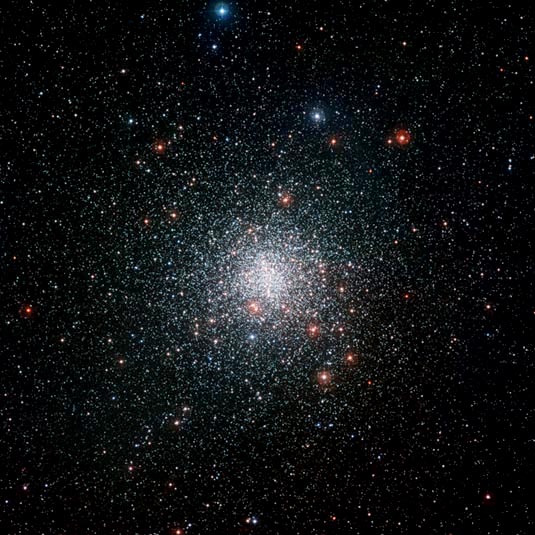
Description: Globular Cluster
Position: RA 16h 23m 35.22s Dec -26 31' 32.7"
Constellation: Scorpius
Apparent magnitude: +5.9
Apparent dimensions: 26'.0
Distance: 7000 light years
Image Credit: ESO
Release Date: September 5, 2012
Hubble closeup: S1236
ABOUT THIS IMAGE:
A new image from ESO's La Silla Observatory in Chile shows the spectacular globular star cluster Messier 4. This ball of tens of thousands of ancient stars is one of the closest and most studied of the globular clusters and recent work has revealed that one of its stars has strange and unexpected properties, apparently possessing the secret of eternal youth.
The Milky Way galaxy is orbited by more than 150 globular star clusters that date back to the distant past of the Universe (eso1141). One of the closest to the Earth is the cluster Messier 4 (also known as NGC 6121) in the constellation of Scorpius (The Scorpion). This bright object can be easily seen in binoculars, close to the bright red star Antares, and a small amateur telescope can show some of its constituent stars.
This new image of the cluster from the Wide Field Imager (WFI) on the MPG/ESO 2.2-meter telescope at ESO's La Silla Observatory reveals many more of the cluster's tens of thousands of stars and shows the cluster against the rich background of the Milky Way.
Astronomers have also studied many of the stars in the cluster individually using instruments on ESO's Very Large Telescope. By splitting the light from the stars up into its component colors they can work out their chemical composition and ages.
New results for the stars in Messier 4 have been surprising. The stars in globular clusters are old and hence not expected to be rich in the heavier chemical elements [1]. This is what is found, but one of the stars in a recent survey was also found to have much more of the rare light element lithium than expected. The source of this lithium is mysterious. Normally this element is gradually destroyed over the billions of years of a star's life, but this one star amongst thousands seems to have the secret of eternal youth. It has either somehow managed to retain its original lithium, or it has found a way to enrich itself with freshly made lithium.
Notes
[1]
Most of the chemical elements heavier than helium are created in stars
and dispersed into the interstellar medium at the end of their lives.
This enriched material then forms the building blocks of future stellar
generations. As a result very old stars, such as those in globular star
clusters, which formed before significant enrichment had occurred, are
found to have lower abundances of the heavier elements when compared to
stars, such as the Sun, that formed later.
From Wikipedia:
Messier 4 or M4 (also designated NGC 6121) is a globular cluster in the constellation of Scorpius. It was discovered by Philippe Loys de Chéseaux in 1746 and catalogued by Charles Messier in 1764. It was the first globular cluster in which individual stars were resolved.
M4 is conspicuous in even the smallest of telescopes as a fuzzy ball of light. It appears about the same size as the Moon in the sky. It is one of the easiest globular clusters to find, being located only 1.3 degrees west of the bright star Antares, with both objects being visible in a wide field telescope. Modestly sized telescopes will begin to resolve individual stars of which the brightest in M4 are of apparent magnitude 10.8.
M4
is a rather loosely concentrated cluster of class IX and measures 75 light
years across. It features a characteristic "bar" structure across
its core, visible to moderate sized telescopes. The structure consists
of 11th magnitude stars and is approximately 2.5' long and was first noted
by William Herschel in 1783. At least 43 variable stars have been observed
within M4.
M4 is approximately 7,200 light years away, the same distance as NGC 6397,
making these the two closest globular clusters to our Solar System. It
has an estimated age of 12.2 billion years